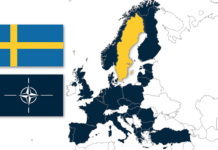Publicus Institute, commissioned by Népszava , measured the public opinion towards Russia’s unprovoked aggression towards Ukraine by surveying 1007 individuals in a nationwide representative poll conducted between the 26th and the 31st of October 2022.
(Ezen kutatás magyar nyelven itt olvasható.)
Seven out of ten responders say that Russia’s invasion of Ukraine is more of an aggression than a defence by the Russians. Back in April 2022, only six out of ten responders said so.
Six out of ten responders think that Viktor Orbán should condemn Russia more harshly for attacking Ukraine. Back in April 2022 only around four out of ten responders said so.
The majority of responders are rather dissatisfied with the pro-Russian foreign policy of the Orbán government before the war. Back in April 2022 only one third of responders said so, meaning that the amount of dissatisfied people has increased by 20 percentage points. Nearly six out of ten responders are rather dissatisfied with the government’s response to the war so far. Back in April 2022, only three out of ten responders said so, meaning that the amount of dissatisfied people has increased by 25 percentage points.
Seven out of ten (69 percent) responders say that Russia’s invasion of Ukraine is more of an aggression than a defence by the Russians. (This number was 64 percent in the February of 2022, 56 percent in April of 2022 , and 63 percent in August 2022 ). Our survey at the end of October shows that this opinion is held the overwhelming majority of the voters of the united opposition (94 percent), six out of ten undecided voters (61 percent), as well as four out of ten Fidesz voters (43 percent).
One- fifth (20 percent) of responders say that Russia’s invasion of Ukraine is more of a defence by the Russians. (This number was 15 percent in the February of 2022, 25 percent in April of 2022 , and 19 percent in August 2022 ). Our survey at the end of October shows that this opinion is held by four out of ten Fidesz voters (42 percent), one-fifth of undecided voters (19 percent), and 4 percent of the voters of the united opposition.
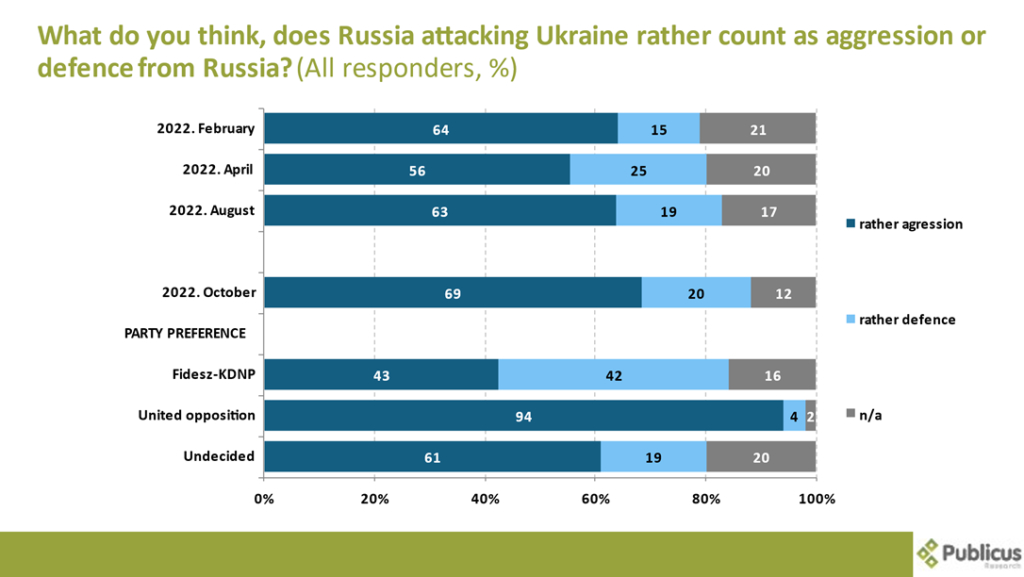
Two out of ten responders (19 percent) say that they are very scared and anxious, while three out of ten (31 percent) responders say that they are somewhat afraid and anxious due to the fact that there is a war happening in a neighbouring country. (In the August of 2022, this ratio was 21 to 27 percent, and 22 to 27 percent in April 2022.)
Our survey at the end of October shows that three out of ten Fidesz voters (29 percent), one-fifth of undecided voters (20 percent), and one-seventh (14 percent) of the voters of the united opposition are very afraid and anxious due to the situation.
Three out of ten responders (30 percent) say that they are not at all anxious about the fact that there is a war happening in Ukraine. In the April of 2022, this amount was 24 percent, whereas in our current survey, four out of ten undecided voters (38 percent), three out of ten of the voters of the united opposition (30 percent), as well as one-fifth of Fidesz voters said so (20 percent).
One-fifth (20) of responders said that they are scared and anxious about the war in the neighbouring country to a varying degree.
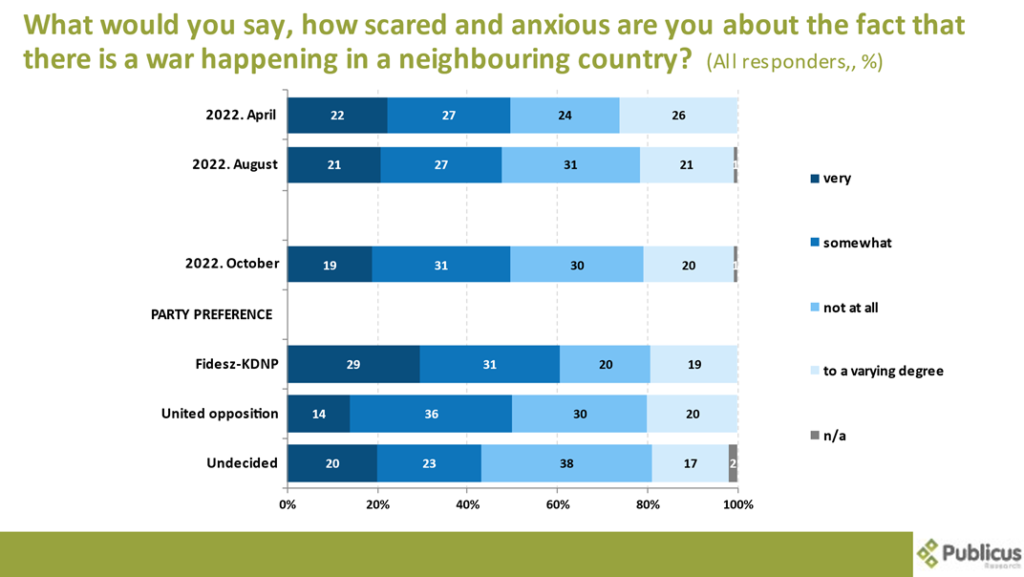
In the recent months, the amount of those who think that it is rather unlikely that the war will spread to Hungary has increased by 6 percent (it was 79 percent in February 2022 and 85 percent in October 2022).
Parallelly to this however, the amount of those who think that it is rather likely that nuclear weapons would be deployed during the war has increased by 7 percent (it used to be 10 percent in February 2022 and 17 percent in October 2022).

Six out of ten (57 percent) responders think that Viktor Orbán should condemn Russia more harshly for attacking Ukraine. (This amount used to be 43 percent in February 2022, 35 percent in Aril 2022, and 48 percent in August 2022).
Our survey at the end of October shows that 15 percent of Fidesz voters, half of the undecided voters (51 percent), the overwhelming majority of the voters of the united opposition (94 percent) agree in this.

The majority of responders (54 percent) are rather dissatisfied with the pro-Russian foreign policy of the Orbán government before the war. (This amount used to be 46 percent in February 2022, 34 percent in April 2022, and 50 percent in August 2022, meaning that compared to April’s results, the amount of dissatisfied peoplehas increased by 20 percentage points.)
Our survey at the end of October shows that the overwhelming majority of the voters of the united opposition (91 percent), four out of ten undecided voters (44 percent), and one-tenth of Fidesz voters (9 percent) said that they are dissatisfied with the pro-Russian foreign policy of the Orbán government before the war.
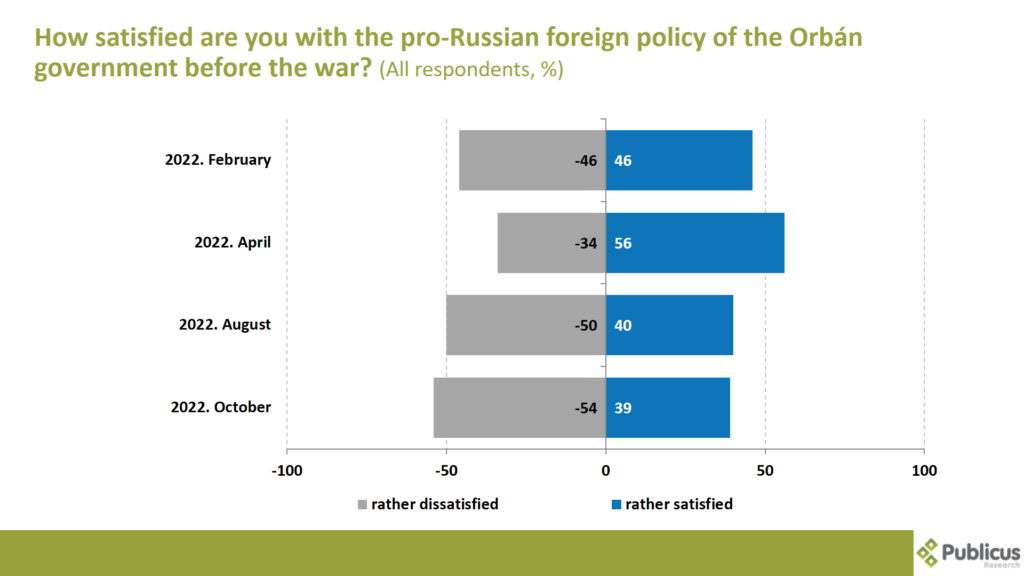
Nearly six out of ten responders (56%) are rather dissatisfied with the government’s response to the war so far. (This amount used to be 35 percent in February 2022, 31 percent in Aril 2022, and 52 percent in August 2022, meaning that compared to April’s results, the amount of dissatisfied peoplehas increased by 25 percentage points.)
Our survey at the end of October shows that nearly all voters of the united opposition (95 percent), half of the undecided voters (51 percent), and 5 percent of Fidesz voters said that they are rather dissatisfied with the government’s response to the war so far.
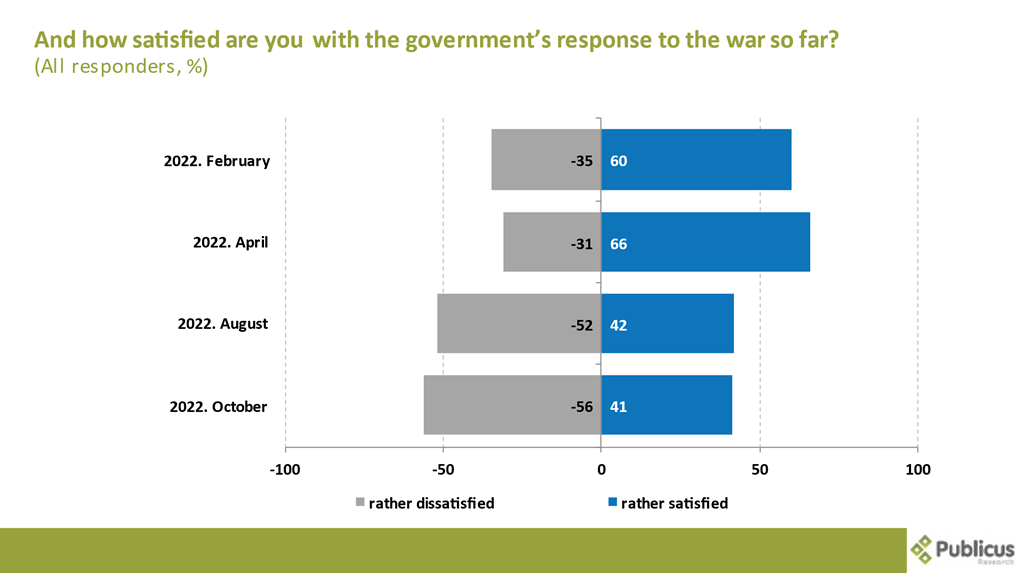
Further details on the results of the research can be found in the print and online editions of Népszava. When referring to this research, please also refer to Népszava.
(Ezen kutatás magyar nyelven itt olvasható.)
Methodology
The survey was conducted by Publicus Institute as a part of Publicus Omnibusz, between the 26th and the 31st of October 2022, polling 1007 individuals via phone, who are representative of the adult population of Hungary. The potential distortions of sampling were corrected with weighting based on the data from the 2016 KSH census data. The attributes of the surveyed accurately resemble those of the Hungarian population by their sex, age, educational attainment, regional and settlement wise composition. With this sample size, we can state with a 95 percent confidence level that the data obtained through testing would only differ by +/-3,1 percent at most from that we would have gotten when surveying all 18 year old or older residents. The statistical error is larger however, when the distribution is configured not to all surveyed, but to certain smaller subgroups.



